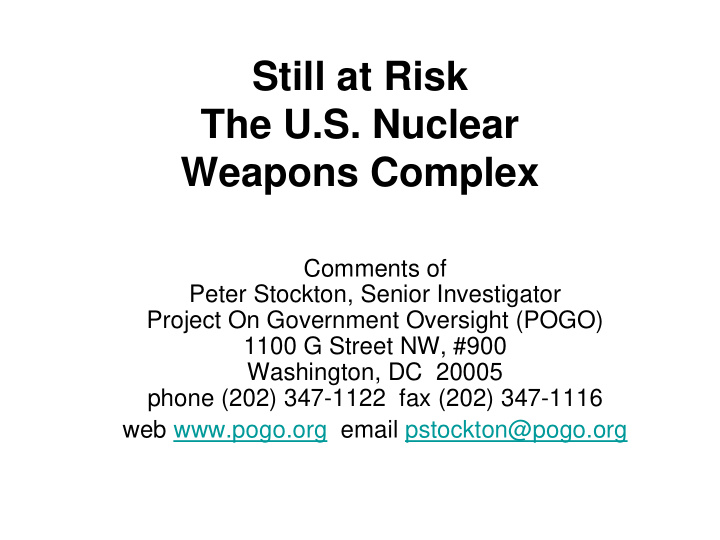



Still at Risk The U.S. Nuclear Weapons Complex Comments of Peter Stockton, Senior Investigator Project On Government Oversight (POGO) 1100 G Street NW, #900 Washington, DC 20005 phone (202) 347-1122 fax (202) 347-1116 web www.pogo.org email pstockton@pogo.org
POGO - Who We Are • The Project On Government Oversight (POGO) is an independent nonprofit that investigates and exposes corruption and other misconduct in order to achieve a more effective, accountable, open and honest federal government. • POGO does not accept any funds from the federal government, corporations, unions, or anyone with a financial interest in the outcome of our investigations.
Nuclear Security Oversight Background • First report, Nuclear Weapons Complex: Security at Risk , released in 2001, since then, five other reports released, generating substantial news coverage and policy change. • Information comes from concerned insiders (NNSA, DOE, DOD, military, NRC, and private contractors) • Senior Investigator Peter Stockton served as personal troubleshooter to DOE Secretary Bill Richardson on physical and cyber security (1999-2001), also as senior investigator for 27 years on House and Senate committees.
Nuclear Security Concerns • Major concern: Too many sites with weapon-grade weapon-quantity (CAT 1) nuclear material – Short timeline to create an improvised nuclear device (IND) – Sigma 20 • High consequence of stolen PU/HEU/warhead
Concerns cont. • In 2001 report, we found that guard forces lost 50 percent of force-on-force (FoF) performance tests. The solution?... Deinventory problem sites – TA-18 • Garden Cart • Kiva 3 – LLNL • lacrosse stick – Y-12 • wooden storage building • 5 targets with CAT 1 • A number of security problems (friendly fire, theft scenario, etc) • HEUMF is not underground as recommended by Hagengruber • Downblending, no plan for increased rate
Design Basis Threat The Design Basis Threat (DBT) is a major driver of cost • 2003 DBT (number of adversaries is less than ½ of 9/11 force) • 2004 DBT (number close to 9/11 force) • 2005 (slightly more than ½ 9/11 force) – Supposed to be implemented by 2008 – Current waivers granted • Y-12 (when HEUMF loaded) • LLNL“non-enduring,” also couldn’t handle 2003 DBT – Gatling gun disaster – Failed 2/3 scenarios
Limitations of DBT • POGO believes terrorist threat to a facility would be squad size or greater, based on DOE and military sources • Our sources claim DOE’s new Graded Security Protection (GSP) is an effort to lower the DBT • F-o-F performance test warnings, unable to test guard force for key advantages of terrorists (surprise, violence of action, & speed). Given these advantages, the guard force should win overwhelmingly • It always comes down to timelines
POGO Concerns with Risk-Based Approach • DOE sources have been through the formulation of risk-based approaches before, all efforts have come apart • DBT is based on the Postulated Threat, which is developed by the intelligence community and is based on real experiences/data, unlike the simulations and probabilities used to develop a risk-based approach
Security Recommendations • Sites should be tested by Grizzly Hitch, who are trained as terrorists as opposed to DOE’s current adversaries who are trained as defensive guard force • Create aggressive schedule for downblending HEU • POGO has sources who are interested in working on this with the National Academies
Security Recommendations cont. • POGO could share a film – Weapons Under Fire, on lethality of weapons available to terrorists (e.g. platter charge, rpgs, 50 caliber API) • DOE should federalize its guard force. Currently there is a controversy between DOE report and upcoming GAO report • Whistleblower retaliation is still a problem and needs to stop for security issues to be addressed
Recommend
More recommend